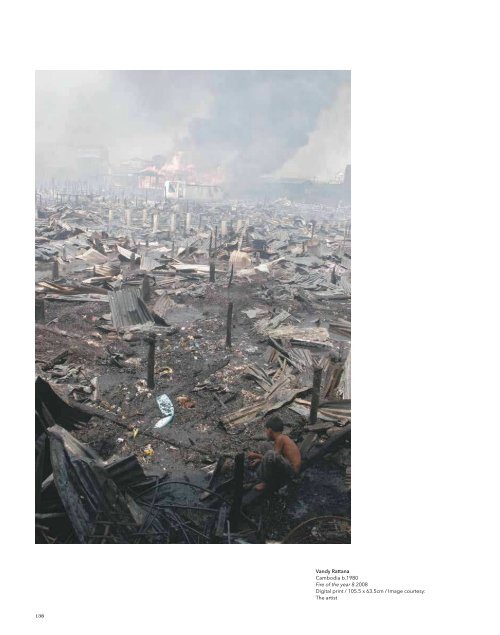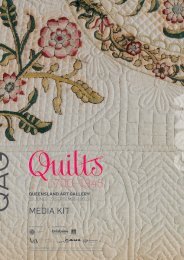Queensland Art Gallery - Queensland Government
Queensland Art Gallery - Queensland Government
Queensland Art Gallery - Queensland Government
Create successful ePaper yourself
Turn your PDF publications into a flip-book with our unique Google optimized e-Paper software.
Vandy Rattana<br />
Fire of the year<br />
Vandy Rattana<br />
Cambodia b.1980<br />
Fire of the year 8 2008<br />
Digital print / 105.5 x 63.5cm / Image courtesy:<br />
The artist<br />
Cambodian photographer Vandy Rattana’s ‘Fire of the year’ 2008 is a<br />
poignant series of images of a blaze on the outskirts of Phnom Penh.<br />
The fire razed the district of Dteuk Tlah (Clear Water), where 300 families<br />
lived cheek-by-jowl in wooden homes above a polluted lake. Most<br />
of the buildings in the district perished, although some were saved<br />
through bribes and negotiations with the fire police. 1 Fires are common<br />
in today’s Cambodia, as Vandy notes: ‘they are part of our lives, like<br />
eating or playing sports’, 2 implying that the most unsettling aspect<br />
of this tragedy is its familiarity. ‘Fire of the year’ powerfully gestures<br />
to a deeper political condition in Cambodia — its expanding urban<br />
populations, and the limited infrastructure available to support them. 3<br />
With their careful composition, these photographs provide a vital<br />
context in which to consider the reality of contemporary life in<br />
Cambodia, a concern which sustains the artist’s practice. These<br />
images are made all the more compelling through their visual<br />
finesse — specifically, the artist’s attention to detail, and his play with<br />
composition and depth of field. In one photograph, a fireman emerges<br />
from a cloud of smoke, framed by the grille of a security door and the<br />
tightly cropped head of an observer in the foreground. In another<br />
image, a fire hose spouts an arc of water into a billowing smoke stack,<br />
while another almost moves into abstraction, with its dense haze of<br />
smoke filling the frame, the outline of a TV antenna barely visible.<br />
There is a moment of sobering gravity — and perhaps precarious hope<br />
— in the final photograph of the series, where a small child, almost out<br />
of frame, fossicks among the debris floating on the lake for materials to<br />
sell on the streets.<br />
Vandy’s photographs evoke the rhythm and pulse of life in Cambodia.<br />
Working in series, he uses light, composition and subtle layers of<br />
colour to build associations between images. Photography is a<br />
practice unique to his generation of artists; his travel within the region<br />
as a resident artist and his experience as a press photographer has<br />
deepened his resolve to represent everyday realities. Vandy’s serial<br />
approach recalls the long history of narrative composition in Khmer<br />
art, where epic stories and legends are vividly illustrated in the fresco<br />
paintings and bas-reliefs of ancient temples. His images also have<br />
an intensely cinematic quality; the frame-by-frame approach and<br />
finely constructed compositions reveal situations of great drama<br />
and consequence, and are perhaps informed by the artist’s strong<br />
appreciation of film culture.<br />
Vandy’s evocative and sharply observed studies of his environment,<br />
however, suggest a passionate commitment to influence and<br />
communicate, rather than to simply document:<br />
My goal is to show life and invite people to examine life. I want my<br />
pictures to have the smell of my mother’s food and the sound of my<br />
father’s stories. 4<br />
This intimacy can be seen in earlier works which portray quiet domestic<br />
interiors and social routines, such as games of chess in the street, as<br />
well as portraits of friends and family. His first solo exhibition, ‘Looking<br />
in My Office’, was a wry and candid portrayal of corporate behaviour. 5<br />
When employed at a telecommunications company, Vandy captured<br />
the inner workings of the office environment by furtively snapping<br />
pictures of his colleagues — applying makeup, draped wearily across<br />
keyboards, and filing, endlessly filing.<br />
More recently, Vandy has undertaken a rigorous exploration of the built<br />
environment of Phnom Penh, where the changing cityscape has been<br />
supported by a meteoric rise in foreign investment. 6 Canadia Building<br />
2007 documents the construction of the capital’s first skyscraper,<br />
while his collaborative project The building 2008 considers the social<br />
and demographic transformation of the city’s first public housing<br />
development, an iconic structure now slated for demolition. 7 As with<br />
‘Fire of the year’, these images are considered observations of daily life<br />
that make critical connections between present-day narratives and the<br />
historical value inherent in chronicling the contemporary moment. As<br />
Vandy Rattana says:<br />
. . . it is important to create images because in Cambodia we lack<br />
an archive. Documentation is both a reflector and creator of history.<br />
We need documentation to help us understand the changes from<br />
generation to generation. 8<br />
Mellissa Kavenagh<br />
Endnotes<br />
1 The fire brigade is colloquially referred to as the ‘fire police’ in Cambodia, as cited<br />
by the artist in an email to the author, 22 August 2009.<br />
2 Vandy, email to the author.<br />
3 The various implications of population expansion, land management and urban<br />
planning in the capital are outlined further in Vann Molyvann, Modern Khmer Cities,<br />
Reyum Publishing, Phnom Penh, 2003, pp.111–15.<br />
4 Vandy, email to the author.<br />
5 ‘Looking in My Office’ was held at Popil <strong>Gallery</strong> in Phnom Penh, Cambodia,<br />
November 2006 – January 2007.<br />
6 In recent times, Cambodia has experienced remarkable change, due in part to the<br />
dual quest for foreign investment and increased economic growth. See Adrian<br />
Levy and Cathy Scott-Clark, ‘Country for sale’, The Guardian, 26 April 2008.<br />
7 Designed by architect Vann Molyvann, ‘The building’ is an example of the school<br />
of Khmer Modernism that flourished briefly under King Norodom Sihanouk in the<br />
1950s and 1960s. Part of an ambitious city planning scheme, it has an important<br />
place in the history of modern Khmer architecture. See Ly Daravuth and Ingrid<br />
Muan, Cultures of Independence, Reyum Publishing, Phnom Penh, 2001, p.11.<br />
8 Vandy Rattana, quoted in Erin Gleeson, ‘Avant-garde blaze new trails’, Phnom Penh<br />
Post, 12 August 2009.<br />
138 139
















